I decided quite suddenly to go for this trip. I must admit that in the past I always only passed by Čačak (pronounced [tʃaːtʃak]), but on the other hand I was in Ovčar Banja numerous times, back in the day, most often with fellow hikers. So, the time came for me to do some more thorough sightseeing and this was also a fine opportunity for a nice, short break. Here is a map with marked monuments of culture and places of interest that I visited.
Since I work as a free-lancer, I decided to do this trip during a working week, counting on smaller crowds. As it turned out, although this was happening very early in the spring, the days were gloriously sunny, with fresh springtime temperature. It was perfect!
There is a motorway to Čačak, but I decided to take the old route known as Ibarska magistrala. Although it was not very crowded even from Belgrade, from the exit to Lajkovac, all the way to Čačak there was hardly anybody on the road. And the day was sunny and beautiful, early spring, fantastic landscapes, an easy road to drive on, nice music in the car... I thoroughly enjoyed it. Then I reached Čačak and there I came across a total traffic mess caused by some roadwork. I must have wasted a good hour waiting there. It was a good patience exercise.
The first place I wanted to visit was not in Čačak itself in fact, but rather in a village nearby. The village is called Atenica and there is an immovable cultural property of exceptional importance – a wine cellar. The wine cellar was built in 1866 and it would have been nice if I had found it, but I didn’t. I got to Atenica and according to the map I was supposed to be near the cellar, but there were no information board, only various agricultural holdings with their houses, so I could not even notice the wine cellar the photo of which I had seen on the internet. I could not see anyone in the courtyards of those holdings in order to ask, but I did stop a couple of vehicles driving by. One man told me that he had been living there for 50 years, but had never heard of something like that. It made no difference that I emphasised that this was a monument of culture of exceptional importance. His answer was the same. Another man could not help me either. So, what was I to do? Nothing. Just go back to my car and move on.
And so, my next stop was the cemetery in Čačak. This may seem odd at first, but there were in fact two monuments I wanted to see there.
The first one is the Memorial Ossuary for the soldiers perished in 1912-1918 and these years refer to the First and the Second Balkan Wars, as well as WWI. Although quite simple by its appearance, this monument of culture is quite original or even, I believe, unique. Namely, the Serbs are traditionally Orthodox Christians and that was certainly particularly pronounced at the beginning of the 20th century. And yet, this did not prevent the raising of this monument in 1934 honouring members of four religions, since soldiers from different armies and of different religions perished in the battlefields around Čačak. It is nice that members of my own nation were so grand and honourable in their victory that they found it worthwhile to celebrate in death all those who left their lives here, irrespective of the religion they belonged to.
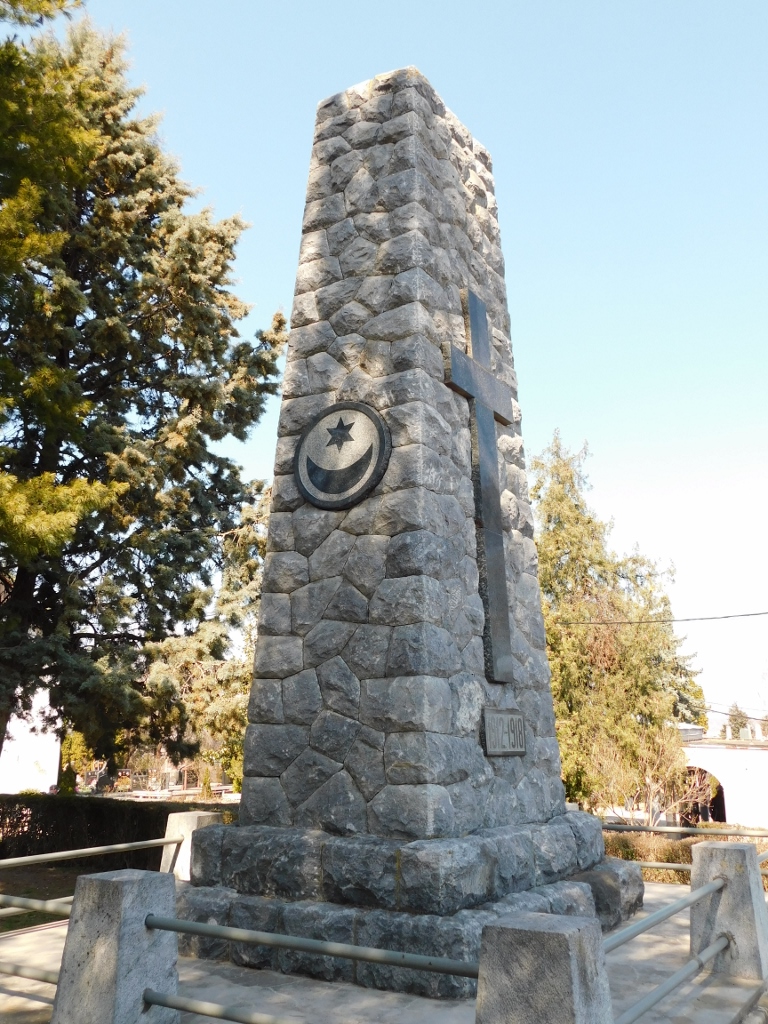 Memorial Ossuary for the soldiers perished in 1912-1918
Memorial Ossuary for the soldiers perished in 1912-1918
Thus, on the front side of the monument one can see an Orthodox cross, on the next one there is a circular plaque with a crescent and a star, the symbols of Islam (previous photo), followed by a Catholic cross and finally a circular plaque with the Star of David, the symbol of Judaism (next photo). The monument was desecrated in 1941 when the German occupation forces, during WWII, ordered the removal of the plaques with the symbols of Judaism and Islam. The monument was repaired later and this can be seen today.
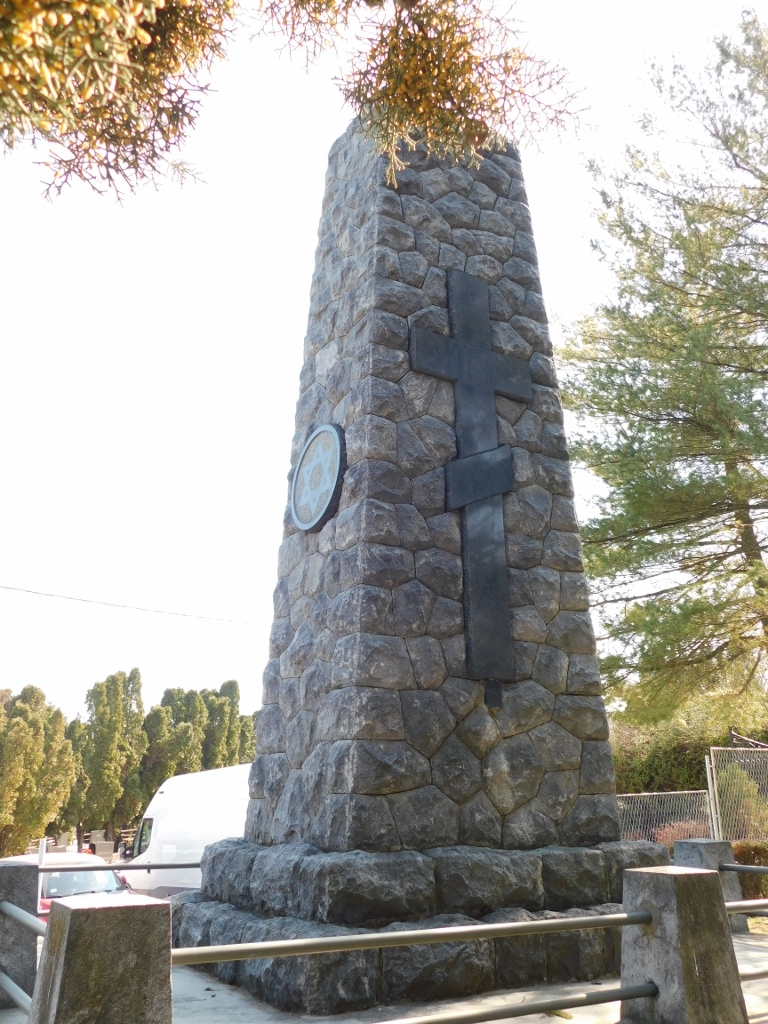 Memorial Ossuary for the soldiers perished in 1912-1918
Memorial Ossuary for the soldiers perished in 1912-1918
There was another place in Čačak cemetery that I wanted to see, but I did not know exactly where it was. This was the grave of Vojvoda Stepa Stepanović, a famous Serbian military officer from WWI (the Serbian military title of vojvoda is the equivalent of field-marshal). I have already written about Stepa Stepanović in my story about a trip around some parts of Belgrade (see: https://www.svudapodji.com/en/belgrade-21/) since he was born in 1856 in Kumodraž, nowadays a part of Belgrade. But, after leaving the active military duty, he retired to Čačak where he had a house and he also died there in 1929. So, he was also laid to rest in Čačak cemetery and I wanted to visit his grave. But, the cemetery in Čačak is big and I hesitated a little. Then I noticed a man who had working clothes on, but he was sitting on a nearby bench getting ready to have his coffee. He was obviously on a break. I approached him and asked him if he knew where the grave of Stepa Stepanović was and he started to explain. Then he concluded that I would not manage on my own, so he left his coffee cup on the bench, got up and led me in order to show the exact direction. When one knows, the grave is not difficult to find at all, but I’m sure that I would have wandered a lot if that wonderfully kind man had not helped me.
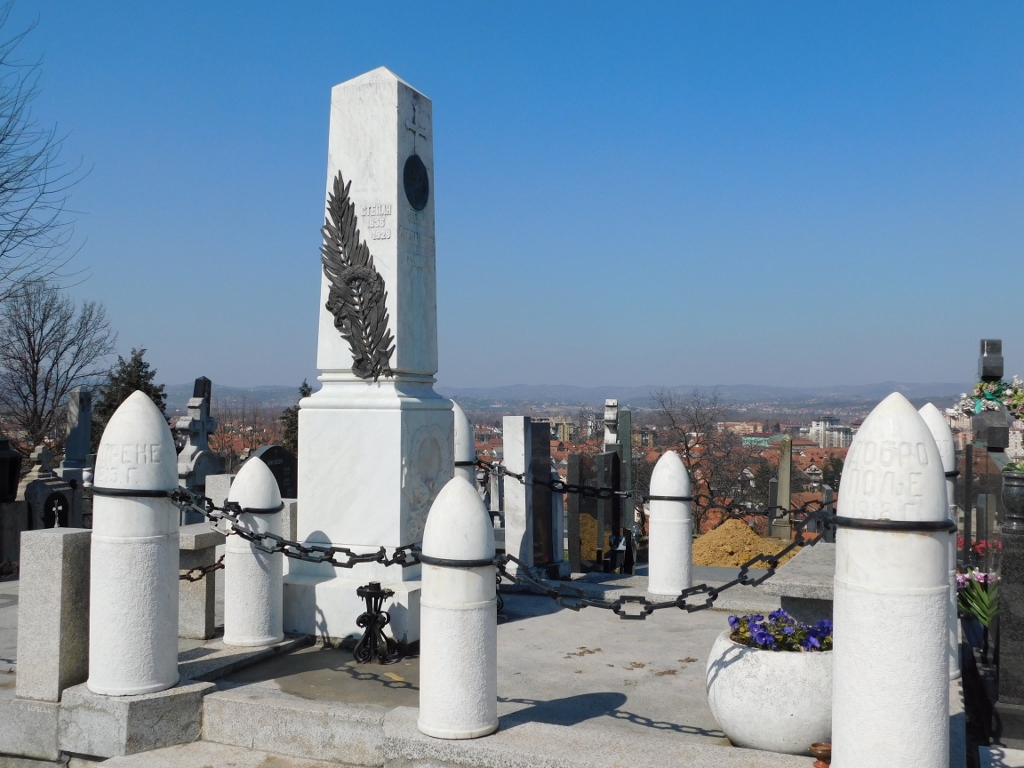 Grave of Vojvoda Stepa Stepanović in Čačak
Grave of Vojvoda Stepa Stepanović in Čačak
After brief silent honouring of the great Serbian military commander, I realised that there was in fact a very nice view of Čačak from that part of the cemetery.
 View of Čačak from the cemetery
View of Čačak from the cemetery
Then I headed back to my car, but along the way I waved broadly to that kind man who was now enjoying his coffee sitting on the bench some 20-30 m away. It wasn’t as if I could shout my thanks, because there were people between us gathering for a funeral that was about to begin. The day was wonderful and sunny, I did see what I wanted, but I was at a cemetery nonetheless.
Now it was the time for me to go down to the centre of Čačak. And so I did, but I had to circle around a little in order to find a parking lot where I could leave my car for a little longer. I wanted to walk around Čačak, without worrying if my parking time was up. At this point I also realised that I was a little hungry.
Since the parking lot was in the very centre, I went quickly over to the walking street and there I entered the first café I came across, their covered section in the middle of the street, to be exact. I could see that they also offered food. In other words, ideal for that particular moment. First I had my coffee that was soon followed by lepinja s kajmakom (Serbian pita bread with kaymak). They also offered pizzas and various other things, but... When in this part of Serbia, the best thing to eat is lepinja s kajmakom. Admittedly, the version offered at this café was a “modern” one, but it was not bad at all. My main objection in fact was not linked to the type of food, but once again I realised why I sometimes don’t like to eat at restaurants during a day. I often think I’m wasting too much time waiting for the food to be brought to me. The restaurants are fine in the evening, when I have more relaxed time and when I’m not doing any sightseeing. But, I was hungry and it was better for me to eat at the place where I had the coffee anyway.
When I finished with what I had at the place, I started with my sightseeing of the centre of Čačak. Moreover, I realised that the café-restaurant in the “terrace” of which I had just eaten was located at the House of Erić, one of the monuments of culture that I wanted to see.
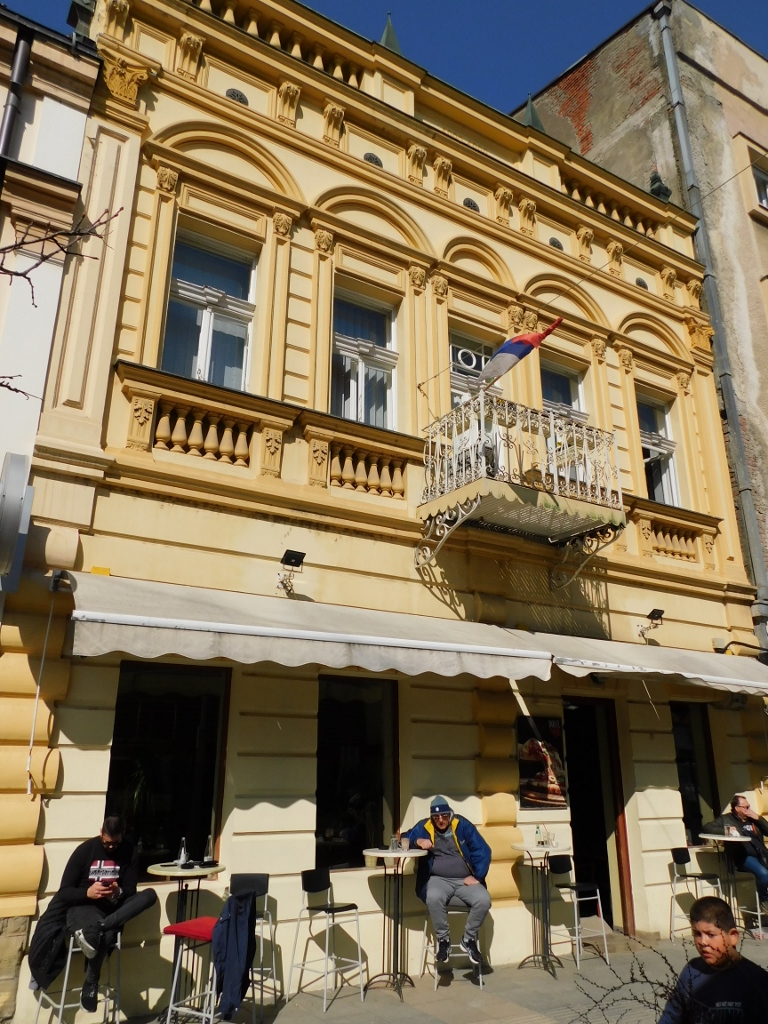 House of Erić in Čačak
House of Erić in Čačak
The house was built in 1892 and it constitutes a representative specimen of an urban structure from the end of the 19th century. The house originally belonged to a merchant family and therefore the commercial premises were on the ground floor, while the residential quarters were on the upper one. The part of the house that was in the backyard was apparently also interesting, but it has been changed in the meantime. Nowadays, the visitor may see the main facade with numerous floral motifs facing the street, although this “terrace” that belongs to the café is some kind of a pre-fabricated structure in the middle of the walking street that prevents a clear view of the House of Erić. This can be done only when one stands to the sides of it; either one. The year of the construction may also be seen on the front facade.
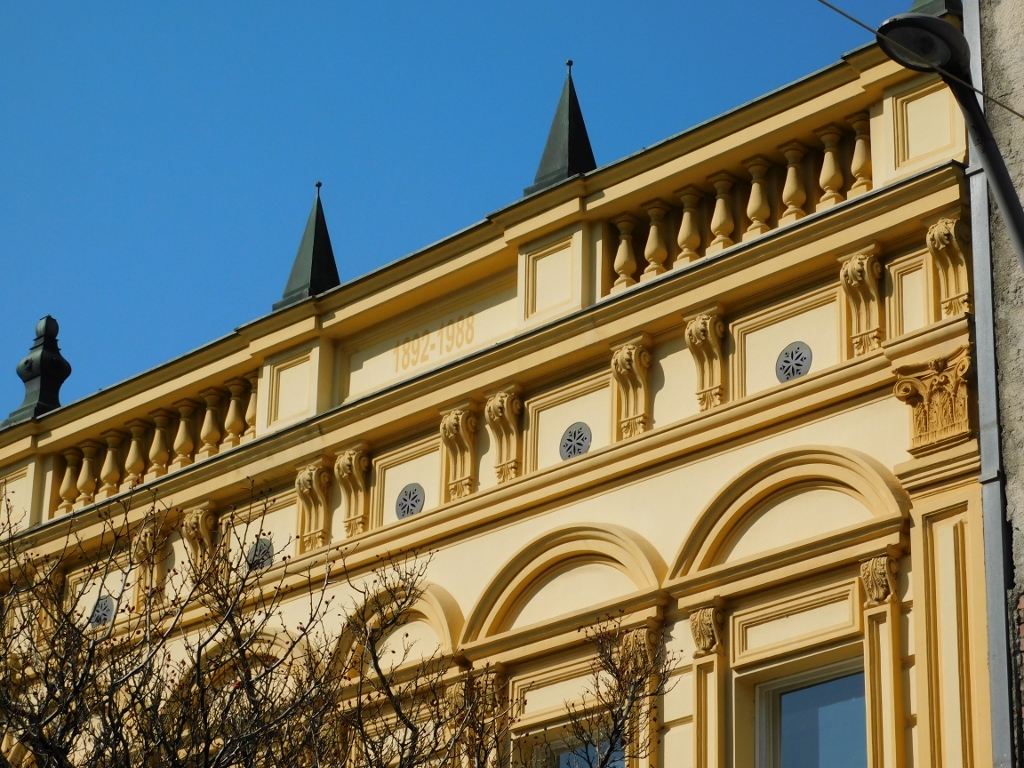 House of Erić, a detail
House of Erić, a detail
Just by coincidence, before this trip I talked with a friend and she drew my attention to something very particular here – a ficus! Although this may seem banal, it was not in fact and only reminded me that I had forgotten to check the “monuments of nature” that may be found in the part of Serbia I was visiting. Because, this ficus in Čačak is under the protection of the state.
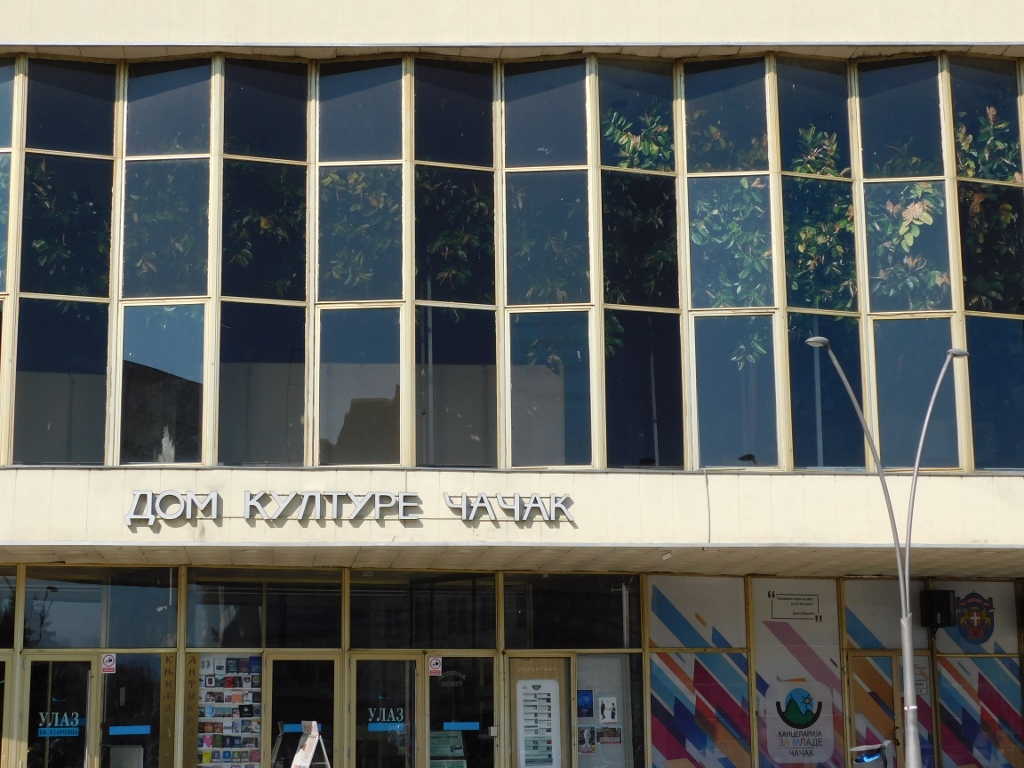 Front facade of the House of Culture Čačak – parts of the ficus may be seen on the upper floor
Front facade of the House of Culture Čačak – parts of the ficus may be seen on the upper floor
Apparently, this is the biggest ficus in the Balkans. It is a variant of the rubber tree (Ficus elastica decora) that may grow into a seriously large tree in the areas where the climate suits it. Here, however, this is a decorative variant planted within the House of Culture back in 1971 and, since it just kept growing, in 2004 it was declared an important natural rarity.
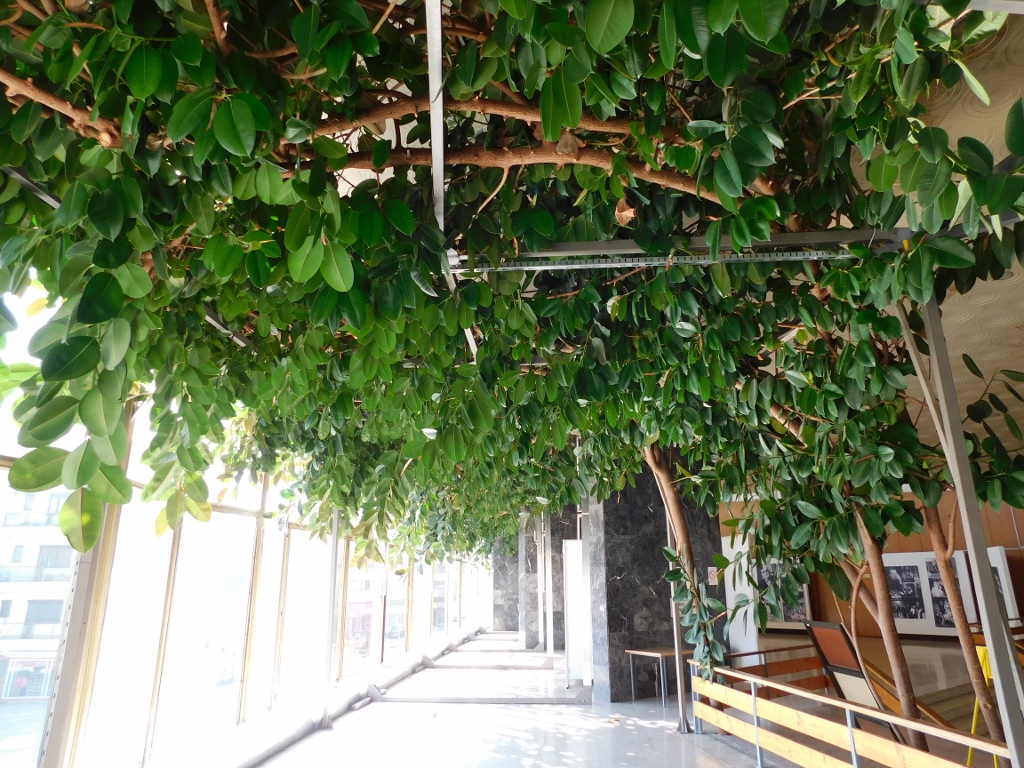 Ficus from the House of Culture Čačak
Ficus from the House of Culture Čačak
What makes it exceptional are its dendometric features: the height of trunk to foliage is 8 m, the circumference of the trunk is 37.4 cm, the length of tree-top with foliage is 38 m (!!!), while the maximum width of the foliage is 5.6 m. I could take a photo of the ficus also using the panorama mode.
 Ficus from the House of Culture Čačak
Ficus from the House of Culture Čačak
The House of Culture Čačak is situated in the central town square – the Uprising Square. In the following photo this is the second large building from the right-hand side.
 Uprising Square, Čačak
Uprising Square, Čačak
Right next to the House of Culture Čačak, actually on the corner of the same building, there is also the tourist office, so I went there to check a couple of details I could not find when getting ready for this trip.
One of those things was that I was trying to find the location of the House of Aleksa Pušeljić, since the materials I had said it was located in Maršala Tita street (named after the former president of the SFR Yugoslavia). Following the dissolution of Yugoslavia, Marshal Tito became the favourite ostracised figure in many circles, the fashion had changed and so had the views at the history, so many streets and institutions that used to bear his name had these changed. This was the case here as well, but I did not know the new name of the street now, so I asked one of the two women that I found at the Info Centre if she knew the present name of the former Maršala Tita street, since she obviously had never heard of the house of Aleksa Pušeljić.
Now she started telling me that she did not know which street this was and that she did not remember for she “must have been a small child” at the time. I looked at her more closely, seeing her wrinkles and thought we were of the similar age, so I almost doubled with laughter, but I managed to keep quiet. She was kind, however, saying she would call a former colleague because “he was 70 now and he would certainly know.” And indeed he knew. As it would turn out, this is one of the most representative buildings in Čačak, in a prime location and I went to see it a little later.
For the time being, I headed for the Roman baths that are located in the very downtown area of Čačak and are considered a monument of culture. The entrance is free, but the site is open only on Tuesdays and Thursdays from 9 am to 3 pm.
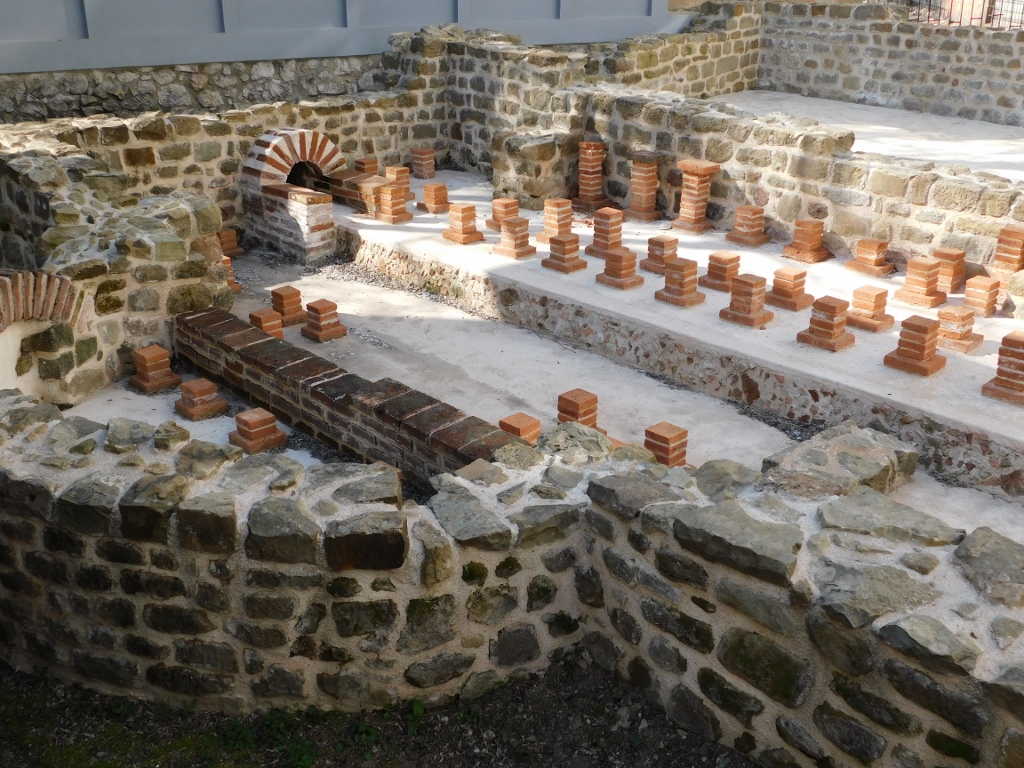 Roman baths
Roman baths
The baths were discovered in 1970 during some construction works. Subsequent exploration has revealed that they date back to the end of the 3rd century CE and that they were used until the end of the 4th century. Although not particularly big, the thermae include all the segments typical of the Roman public baths. Still, the archaeologists have not managed to establish whether the baths used to be a part of some agricultural estate or a settlement. What is, however, clear today is that the remains of the Roman baths are situated right in the middle of the town.
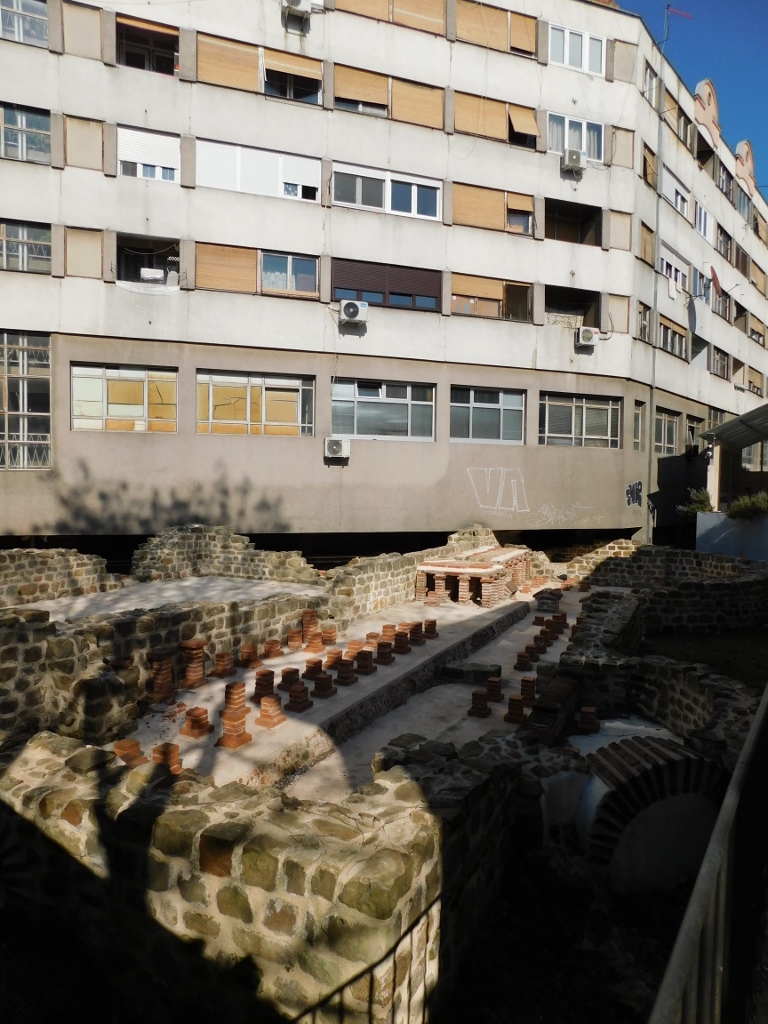 Roman baths and a residential building in Čačak
Roman baths and a residential building in Čačak
Then I walked to another monument of culture that is quite naturally located near the railway station in Čačak. This was, as the materials I used claimed, a railway locomotive of the 85-005 series with a tender. By the way, a tender is a railway wagon carrying coal used as the fuel for the operation of the locomotive.
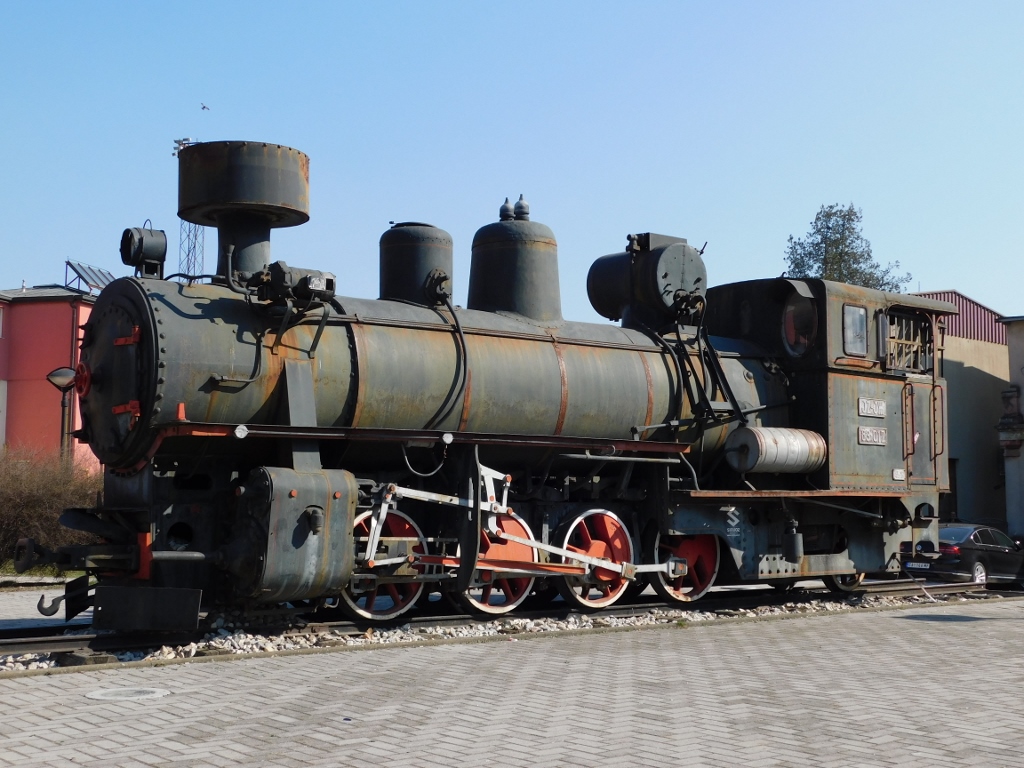 Railway locomotive
Railway locomotive
In fact, what is displayed in front of the railway station in Čačak today is not the original locomotive mentioned in the documents (manufactured in Budapest, Hungary, in 1930 and decommissioned in 1974), since it had been transferred to Zrenjanin, Serbia, for an overhaul. What can be seen in its place is a locomotive without a tender, also manufactured in Budapest in 1929 and belonging to the 83-017 series. This is the right place for all old-train aficionados.
I merely took a photo of the old locomotive and returned to the centre, soon reaching another monument of culture and that was the House of Aćimović.
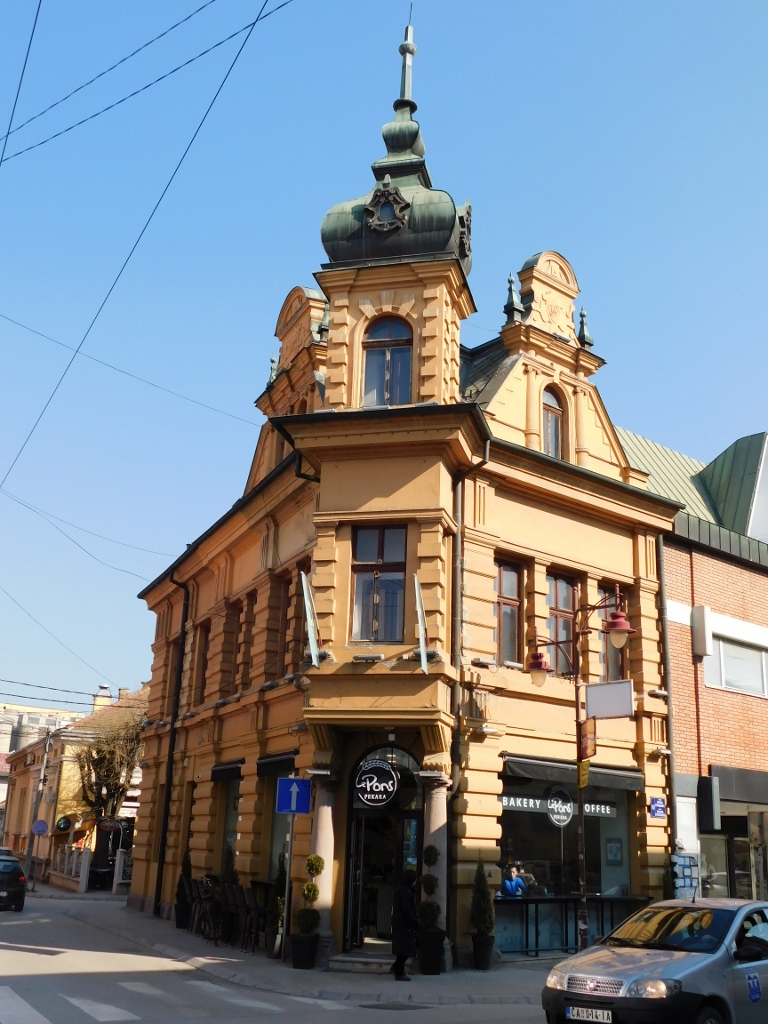 House of Aćimović
House of Aćimović
This house was built in 1903 and it belonged to a wealthy merchant Nikola Aćimović. It is a structure that is believed to be the finest example of the late Baroque in Čačak. It consists of the ground floor (still used as commercial premises nowadays), an upper floor and a mansard. The architectural elements of the mansard are particularly interesting. On the corner there is a tower with a typical Baroque ending, next to the windows on the attics there are pilasters of the Ionic order, while above the windows in the middle of the semi-circular endings of the attics one can see the monogram of the owner – NA.
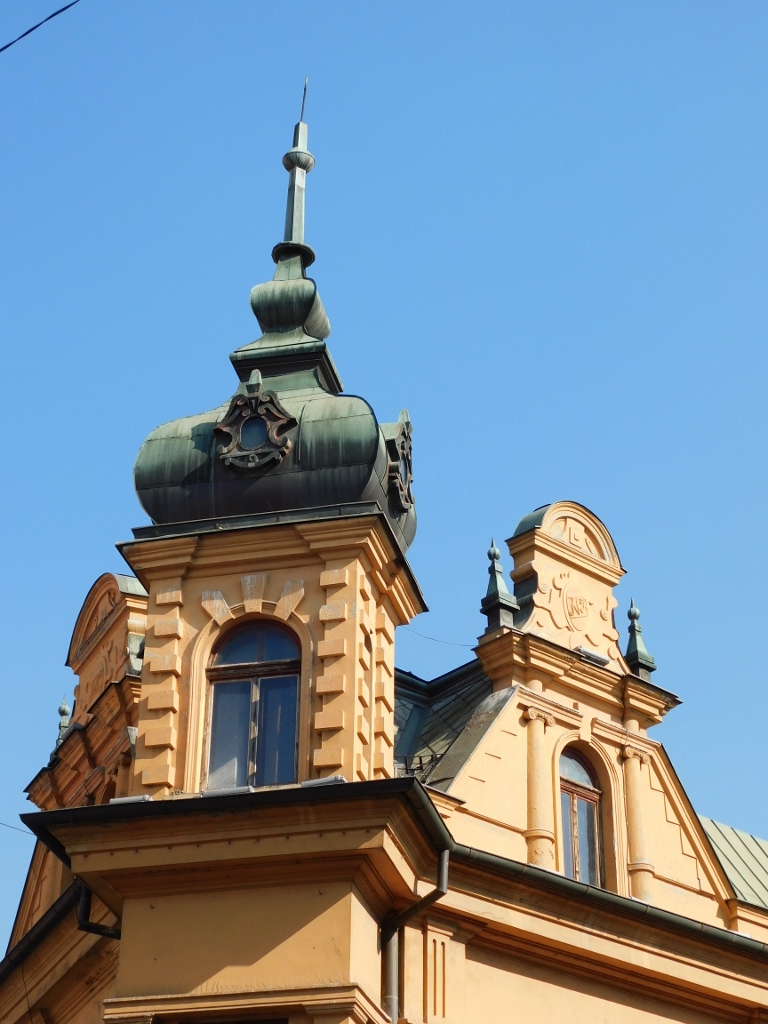 House of Aćimović, a detail
House of Aćimović, a detail
Not far from there, in the downtown area, there is the Grammar School of Čačak.
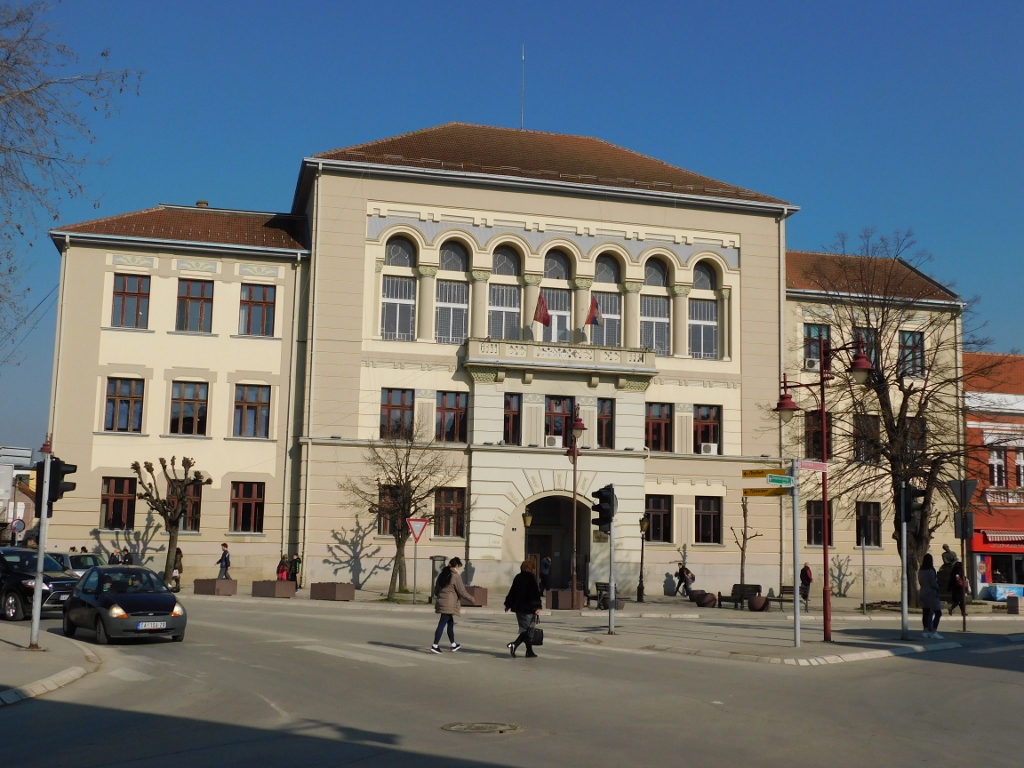 Grammar School in Čačak
Grammar School in Čačak
In the same part of the town one can find the Town Hall, District Administration building, National Museum, as well as the main church in the town. It was precisely by building the grammar school in this location that the emphasis was put on the education and upbringing of the young. The design for the grammar school was done in 1912 and the works started right away, but they were stopped in 1914 because of the onset of WWI. The construction continued after the war and the grammar school officially started to be used in 1927. The architectural characteristics of the building are certainly interesting, but they are far too expertly for my humble travel story, so I will not go into that, but I did go into the grammar school itself. At that point I realised that I had not entered any school for a very long time, so I even found this interesting.
I immediately came across one of the “duty students” and I told him right away I was a tourist visiting Čačak, so I came to see the grammar school, because it is an important monument of culture. The young man looked at me a little confused, but he was certainly very kind. I wanted to have a peek at the inner courtyard, so I went to the back door. Since it was locked, the boy wanted to go and look for the key, but I said it would not be necessary. I contended myself by looking at the courtyard through the glass door, but I took a photo of a cabinet placed in the central hall with numerous trophies won by the students of this grammar school. Really impressive!
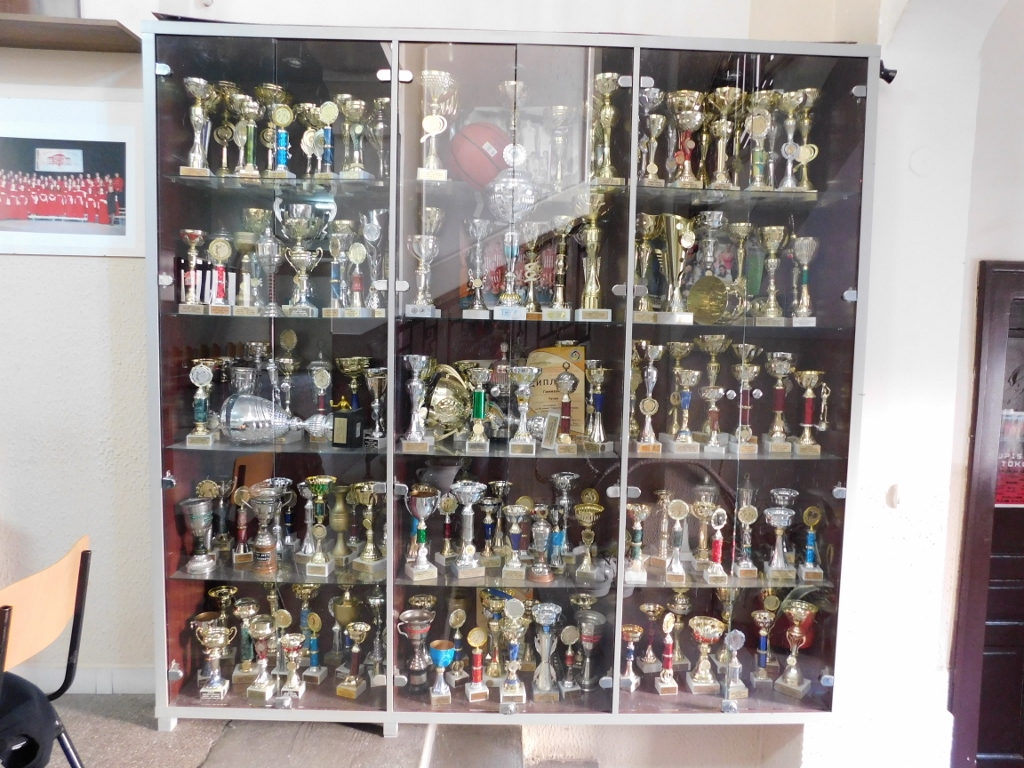 Trophy cabinet of the Grammar School in Čačak
Trophy cabinet of the Grammar School in Čačak
In front of the Grammar School there is a monument to Nadežda Petrović.
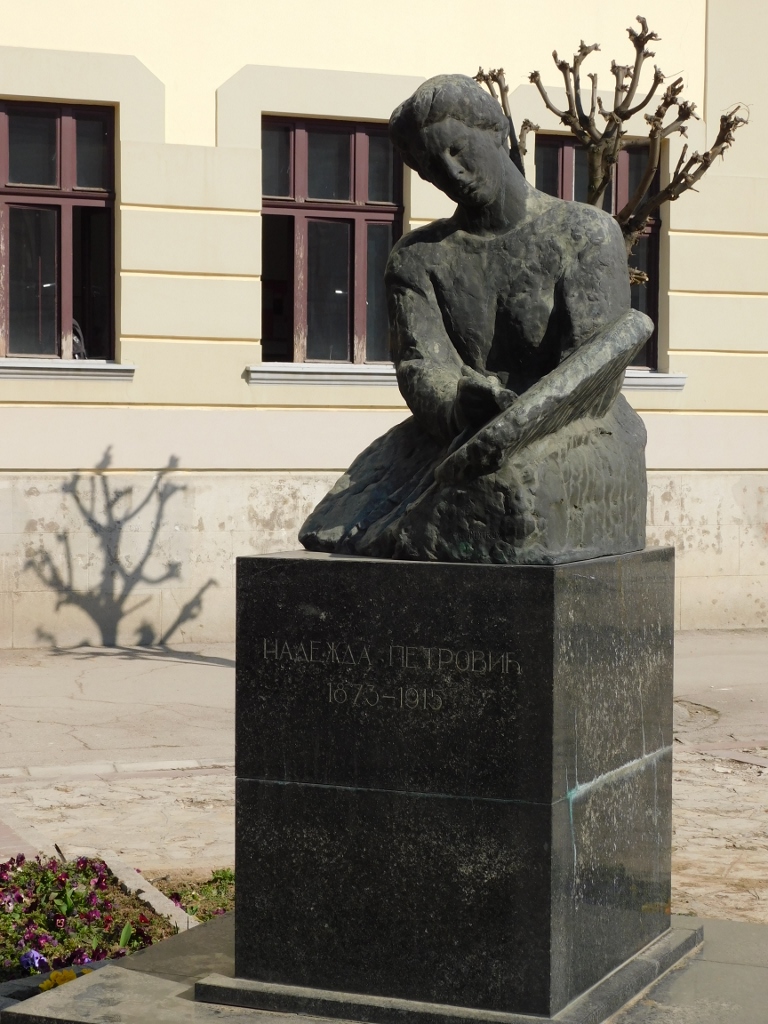 Monument to Nadežda Petrović
Monument to Nadežda Petrović
Nadežda Petrović (1873-1915) is a famous Serbian painter and the first female war photographer. She was born precisely here in Čačak. She got her education in Belgrade and Munich, Germany. During the Balkan Wars (1912-1913) she accompanied the Serbian army on the front as a voluntary nurse. Then came WWI and Nadežda Petrović registered again as a voluntary nurse. She died of typhoid fever in Valjevo in 1915. Today, her image may be seen on the 200 Serbian dinar bill, while the reverse side of the banknote shows the image of a famous photo of Nadežda Petrović as a nurse from 1913.
As for me, since I had seen what I wanted at the Grammar School and around it, I started with a search for a house of national hero Milan-Bata Janković that is enlisted as a monument of culture. I even had the address of the house (the street is also named after this hero), but it turned out to be wrong. Along the way, I walked past a very pretty house and thought that it was such a nice thing that somebody bothered to maintain well an old house in the centre of the town. As it turned out, this was in fact the very house I was looking for.
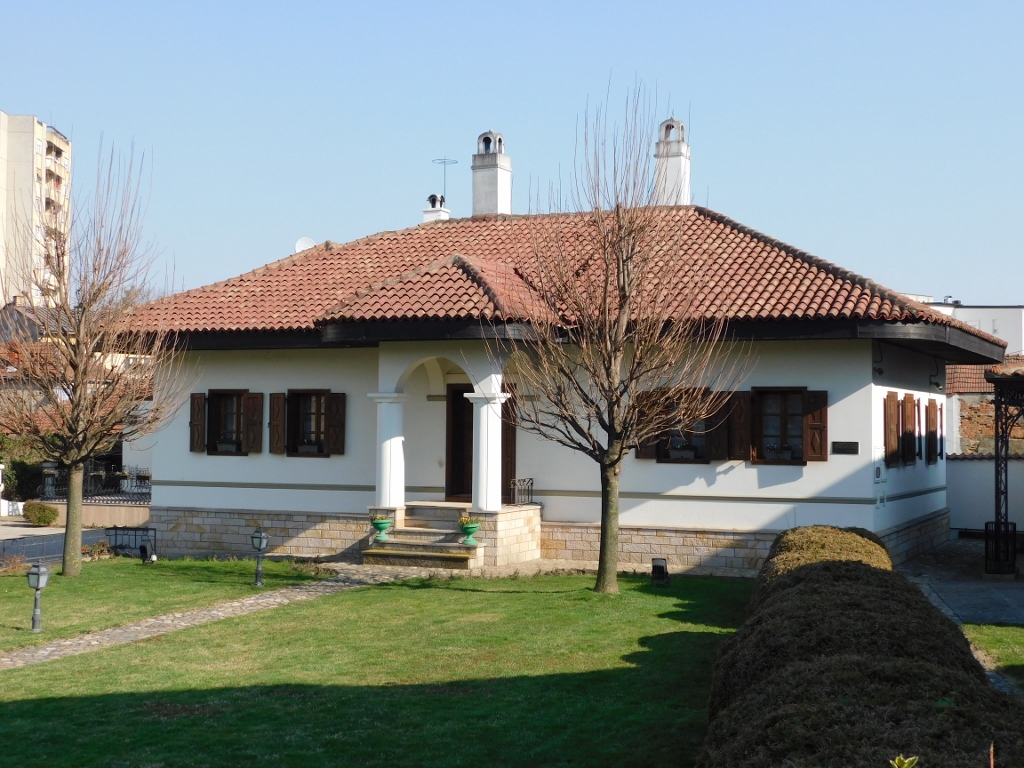 Monument of culture in Bate Jankovića street
Monument of culture in Bate Jankovića street
I have actually dug out all sorts of things about this house. Some people say that the Janković family lived here as tenants in fact, but they were communists and after WWII they took over the ownership of the house. Later they gave the house to the state, i.e., to the town, as a gift and for a while the place housed the Museum of the Revolutionary Youth, while also being called the Town House. Following the enactment of the Restitution Law, the rightful owners, i.e., their heirs appeared on the scene and apparently they asked for a lot of money, which the town did not have or did not want to pay. Then came a wealthy local businessman, so he bought the house and the piece of land that belonged to the house. Behind this historic one, there is another house obviously built more recently, albeit similar in style. I could not quite grasp what is happening with this historic house, i.e., whether it is used for anything, but it is located quite clearly in a private piece of land and the fact remains that it is very nicely restored from the outside and surrounded by a well maintained garden.
Be as it may, the house was built in the first half of the 19th century.